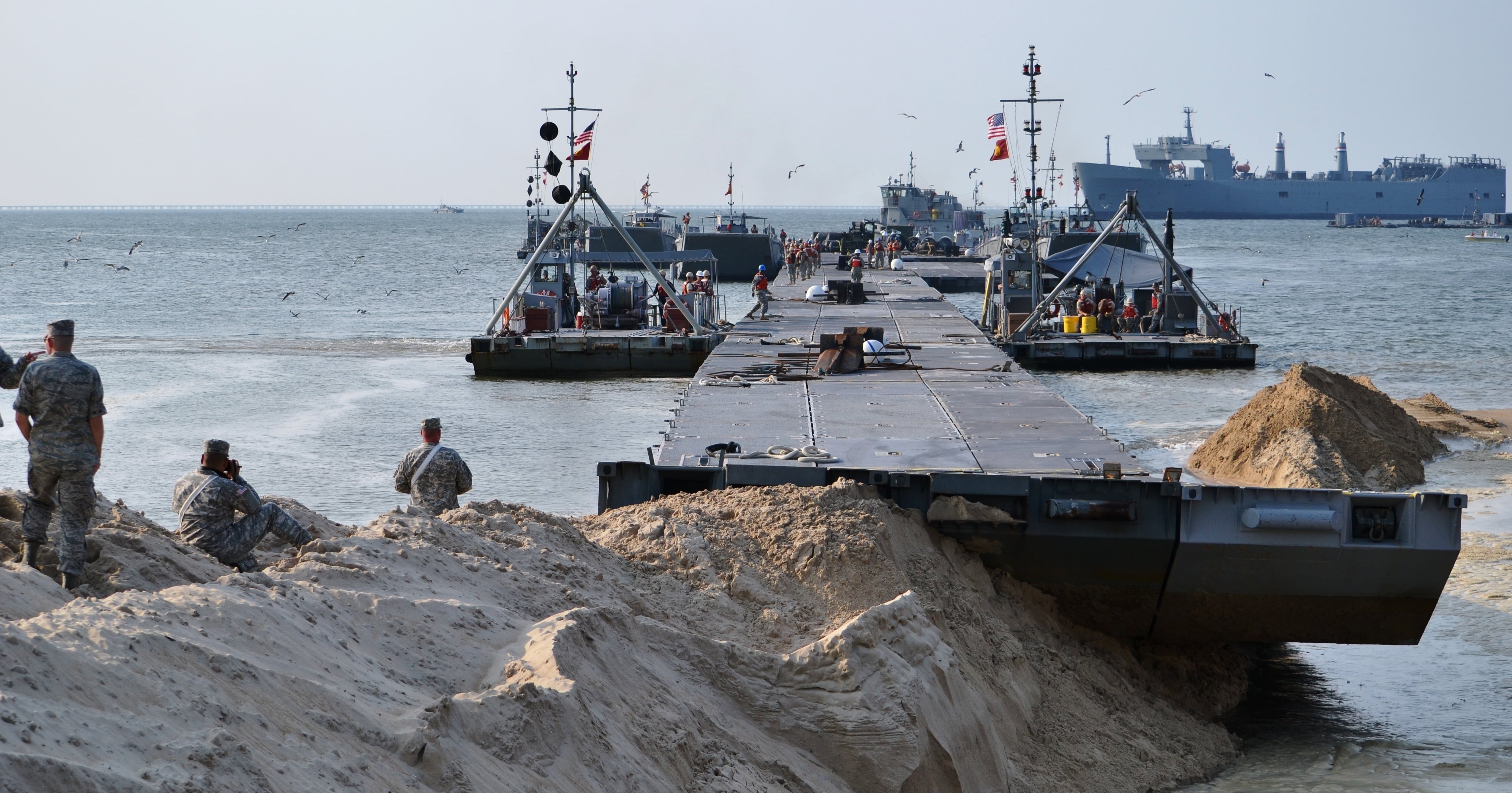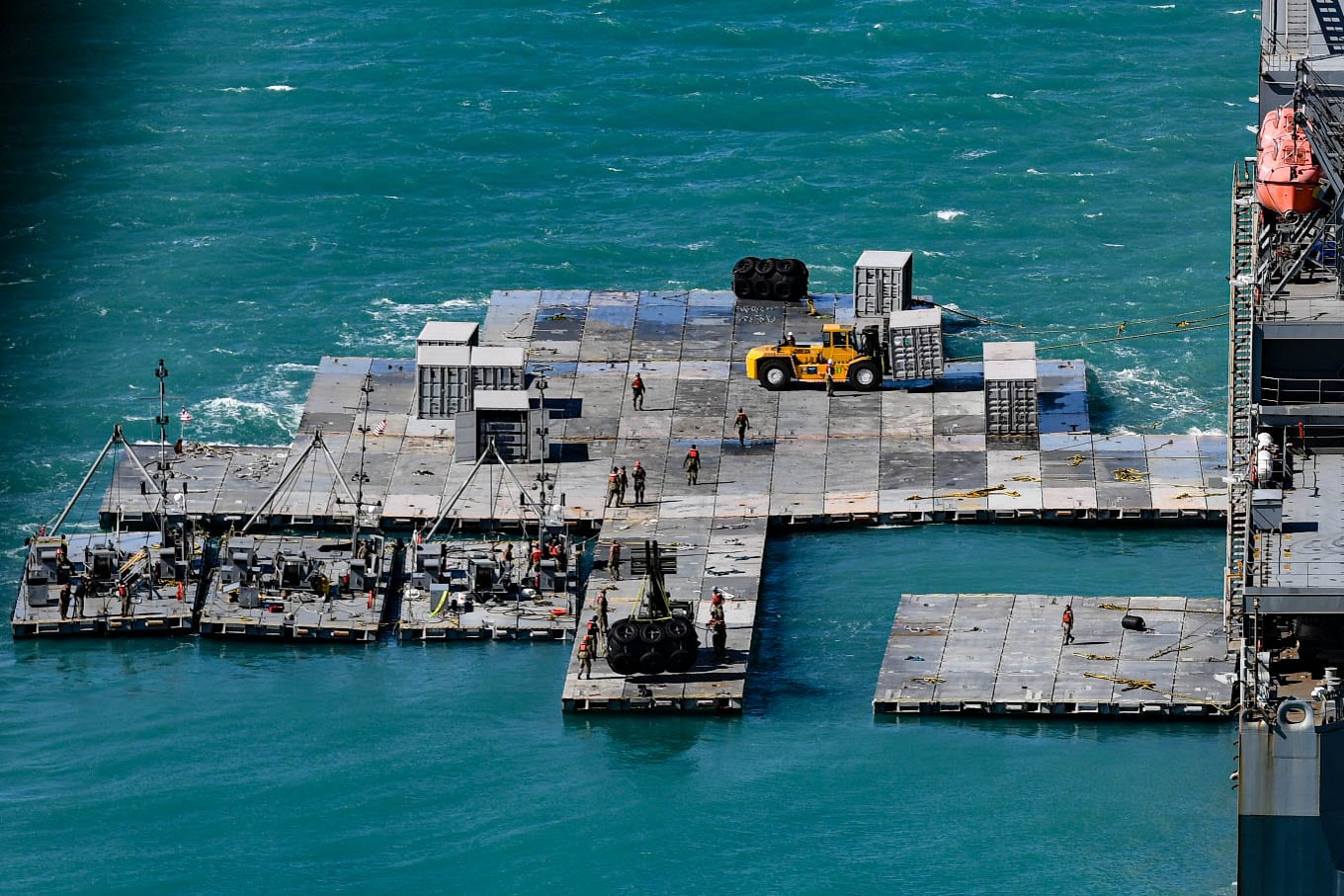Navy cargo ships Roy P. Benavidez, 2nd Lt. John P. Bobo, and 1st Lt. Baldomero Lopez are poised to head to the eastern Mediterranean Sea with more than 250 sailors to help build a humanitarian aid pier off the Gaza Strip, Navy officials confirmed Wednesday.
Sailors will join at least five Army vessels taking part in the plan that the Pentagon says will use the Joint Logistics Over-The-Shore, or JLOTS, capability to construct a floating dock-like staging point, as well as a pier extending to land, for the delivery of humanitarian aid to Palestinians, according to Navy officials, who spoke on condition of anonymity.
Roughly 260 sailors from Naval Beach Group 1 will set up a 72-foot-wide by 270-foot-long floating dock three miles off Gaza.
They will also operate the causeway ferries connected to the pier, and will offload cargo into trucks that will deliver aid to Gaza, Navy officials said.
RELATED

The Benavidez will carry Army equipment to the region, while the Bobo and the Lopez will transport Navy assets.
A logistics pad will exist on the beach, but Navy officials reiterated that no U.S. personnel will operate on the ground in Gaza, and that the Bobo and the Lopez will remain on station with sailors for the duration of the mission.
Of the 260 sailors partaking in the mission, the majority are boatswain’s mates who will build the discharge facility, Navy officials said.
Some Seabees will also participate in the mission as equipment operators, and a handful of corpsmen and quartermasters will also be on station.
Navy officials said the ships have not yet departed for the mission, and they did not provide a timeline for when they expect their role in the mission to conclude.
Navy officials also noted that the JLOTS mission is Army-led, and the Navy is there to help erect the pier under Army command. The Army’s 7th Transportation Brigade from Joint Base Langley-Eustis, Virginia is spearheading the initiative.
Army logistical support vessels Monterrey, Amoros, Wilson Wharf, James A. Loux, and Gen. Frank A. Besson, Jr. departed earlier this month to support building the pier.
“Our capabilities mesh well, and we have already coordinated at the tactical level how we will implement the movement of cargo,” a Navy official said. “This is a routine mission for us, and we’re just falling in together in step to conduct this mission.”
The Army and the Navy will utilize the same structure they did during exercises like Exercise Talisman Sabre last year – a joint exercise between the U.S. and Australia where the 7th Transportation Brigade and Naval Beach Group 1 teamed up to establish a discharge facility and causeway.
President Joe Biden first unveiled plans to construct an offshore pier to allow delivery of humanitarian aid to the Gaza Strip during the State of the Union address earlier this month.
According to Air Force Maj. Gen. Pat Ryder, the pier is part of a larger, international effort to provide aid to Gaza and that the pier will be operational in less than two months.
“We expect the pier to be fully operational in approximately 60 days, which will be able to facilitate the delivery of up to 2 million meals daily,” Ryder told reporters earlier this month.
It remains unclear how the U.S. military will protect American service members, the offshore staging area and the causeway itself from attacks by the Palestinian militant group Hamas, though Ryder said earlier this month that Israel is part of the planning process and could provide security through its own forces.
“If Hamas truly does care about the Palestinian people, then again, one would hope that this international mission to deliver aid to people who need it would be able to happen and unhindered,” Ryder said.
The causeway has the potential to increase the amount of aid flowing into Gaza by several orders of magnitude, supplementing trucks arriving daily through the border with Israel, as well as ongoing air drops by the U.S. military.
U.S. Central Command has conducted at least 14 food drops to Gaza in recent weeks. Each plane carries about the same amount of aid as a truck does over land. Though at points during the Israel-Hamas war, up to 200 aid trucks drove into Gaza daily, the Pentagon said earlier this month that the pace has dropped to 100 or fewer trucks a day.
The temporary port has the potential to pick up some of the slack, Jonathan Lord, senior fellow at the Center for a New American Security, told Military Times this month, but with the same distribution concerns as aid arriving over land.
“How do you get aid not just onshore, but then securely distributed, such that it goes to everyone who needs it, and isn’t otherwise blocked in by Hamas insurgents, criminal gangs, vigilantes or others that might be taking advantage of emerging security vacuums?” he said.
Non-government organizations, the United Nations and other regional partners could be tapped to accept and distribute the aid ashore, Ryder said, though those details aren’t finalized.
Another issue is the inspection process for aid, which has slowed down the flow in land shipments.
“If you ask, the Israelis would argue that they, in fact, are not the bottleneck. They are inspecting more trucks than are actually going in on a day-to-day basis,” Lord said. “And when you ask them to what do they attribute that delta, they would say that the groups operating in Gaza don’t have enough drivers.”
Others, including two U.S senators, say Israel’s “cumbersome” and “arbitrary” inspection process is holding things up, comments the lawmakers made after a trip to Egypt to observe the Rafah border crossing in January.
“So that poses a question: Is, in fact, the problem one of a deficit of aid or deficit of aid distribution?” Lord said. “Likely, we’re going to find out, because if you can bring containerships worth of aid up to Gaza, you’re going to find out very quickly what your logistical supply line and your interior lines look like, and whether you have the capacity to effectively distribute it, in pretty short order.”





